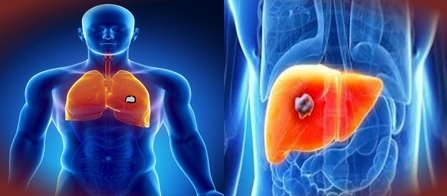Difference between Lung Abscess and Liver Abscess

Difference between Lung Abscess and Liver Abscess
Abscess is defined as a collection of pus in any part of body that is specified to that area. Pus can be found anywhere in the body. It can be external one for example on the skin or inside the body organs like liver, lungs or nose. Pus is a collection of dead bacteria, dead inflammatory cells and fluid so abscess is a complicated bacterial infection. It can be treated through antibiotics but if progressed to advanced stage, it needs surgical drainage. Following article shows a comparison between characteristics, diagnosis and treatment of lung and liver abscess.
Lung Abscess
It is a collection of pus in a large lungs cavity and is lined by chronic inflammatory tissues. Pus escapes from these tissues and ruptures into the bronchus. It mainly results from anaerobic infection as a complication of aspiration pneumonia. X- ray chest shows a single thick walled cavity with air-fluid level. Suppurative infections like pneumonia caused by staphylococcus, klebsiella and pseudomonas also cause lung parenchyma necrosis and abscess formation. But abscess formed by these organisms are multiple. Antibiotic therapy is given until x ray chest shows improvement.
Liver Abscess
Liver abscess is the collection of pus in the parenchyma of liver. It is usually solitary and is located in the right lobe of the liver. Liver abscess may be pyogenic i.e. caused by bacterial infection, aemoeboic abscess is caused by entaemeoba histolytica and third type is hydatid liver abscess. Liver abscess is dangerous in the long run so it needs urgent treatment. Cure rate of liver abscess is 90 percent with proper treatment. Treatment includes aspiration in case of single abscess and antibiotic therapy if multiple abscesses are there. Course and choice of therapy depends upon the report of culture and sensitivity.
Lungs Abscess VS Liver Abscess
Etiology:
Lungs abscess is caused by aspiration pneumonia, poor dental hygiene, suppurative pneumonia and spread form amebic liver abscess.
Liver abscess is caused by intestinal bacteria commonly through staphylococcus aureus, E.coli, salmonella, entamoeba and anaerobic organisms.
Symptoms:
In lungs abscess, patient shows high grade fever with cough which has large amount of sputum.
In liver abscess, patient has fever, chills, malaise and abdominal pain.
Signs:
Patient has weight loss, copious sputum, clubbing and signs of consolidation in lung abscess.
In liver abscess, patient has elevated diaphragms, cough and shoulder pain.
Investigations:
In lung abscess, x- ray chest, ultrasound chest, sputum examination, sputum culture and sensitivity test and complete blood count is carried out.
In liver abscess, complete blood count, liver function tests, blood culture, ultrasound abdomen and CT scan is required.
Complications:
Lungs abscess can complicate into bronchiectasis and fibrosis.
Liver abscess can complicate into rupture, metastatic spread to lungs and secondary infection.
Treatment:
In lungs abscess, antibiotics are given. But surgical drainage may be required through chest tube.
Liver abscess is also treated through pharmacological antibiotic regimen or drainage.
Conclusion
Abscess can develop in any part of the body and it needs antibiotic treatment along with drainage through chest tube or ultrasound guided aspiration.


Leave a Reply